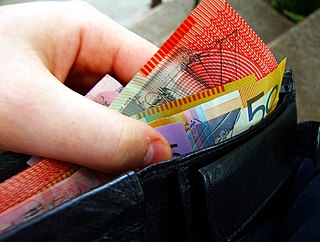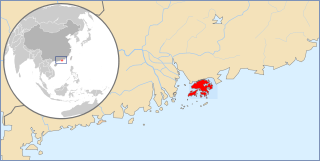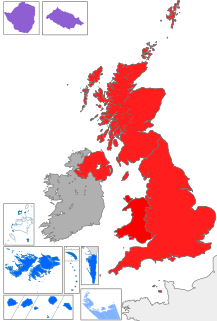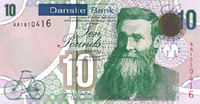Related Research Articles

Sterling banknotes are the banknotes in circulation in the United Kingdom and its related territories, denominated in pounds sterling.

Clydesdale Bank is a trading name used by Clydesdale Bank plc for its retail banking operations in Scotland.

Polymer banknotes are banknotes made from a synthetic polymer such as biaxially oriented polypropylene (BOPP). Such notes incorporate many security features not available in paper banknotes, including the use of metameric inks. Polymer banknotes last significantly longer than paper notes, causing a decrease in environmental impact and a reduced cost of production and replacement. Modern polymer banknotes were first developed by the Reserve Bank of Australia (RBA), Commonwealth Scientific and Industrial Research Organisation (CSIRO) and The University of Melbourne. They were first issued as currency in Australia during 1988 ; by 1996, the Australian dollar was switched completely to polymer banknotes. Romania was the first country in Europe to issue a plastic note in 1999 and became the third country after Australia and New Zealand to fully convert to polymer by 2003.

The issue of banknotes of the Hong Kong dollar is governed in the Special Administrative Region of Hong Kong by the Hong Kong Monetary Authority (HKMA), the governmental currency board of Hong Kong. Under licence from the HKMA, three commercial banks issue their own banknotes for general circulation in the region. Notes are also issued by the HKMA itself.
Banknotes have been issued for use specifically in Northern Ireland since 1929, and are denominated in pounds sterling. They are legal currency, but technically not legal tender anywhere. This is not uncommon as most bank notes are not recognised as tender. However, the banknotes are still widely accepted as currency by larger merchants and institutions elsewhere in the United Kingdom. Issuing banks have been granted legal rights to issue currency, and back the notes with deposits at the Bank of England.

The Bank of England, which is now the central bank of the United Kingdom, British Crown Dependencies and British Overseas Territories, has issued banknotes since 1694. In 1921 the Bank of England gained a legal monopoly on the issue of banknotes in England and Wales, a process that started with the Bank Charter Act of 1844 when the ability of other banks to issue notes was restricted.
Banknotes have been issued by the Bank of Ireland for circulation in Northern Ireland since 1922.
Banknotes of Scotland are the banknotes of the pound sterling that are issued by three Scottish retail banks and in circulation in Scotland. The issuing of banknotes by retail banks in Scotland is subject to the Banking Act 2009, which repealed all earlier legislation under which banknote issuance was regulated, and the Scottish and Northern Ireland Banknote Regulations 2009. Currently, three retail banks are allowed to print notes for circulation in Scotland: Bank of Scotland, Royal Bank of Scotland, and Clydesdale Bank.

Northern Bank Limited T/A Danske Bank is a retail bank in Northern Ireland. Northern Bank is one of the oldest banks in Ireland having been formed in 1809, and forms part of one of the Big Four banks in Ireland. Northern Bank took on the name of its parent company Danske Bank as its trading name in November 2012. It is a leading bank in Northern Ireland and a growing bank in Great Britain. In Northern Ireland the Bank issues its own banknotes.

The Bank of Scotland £5 note, also known informally as a fiver, is a sterling banknote. It is the smallest denomination of banknote issued by the Bank of Scotland. The current polymer note, first issued in October 2016, bears the image of Sir Walter Scott on the obverse and a vignette of the Brig o' Doon on the reverse. The polymer replaces a cotton note also featuring a portrait of Sir Walter Scott.

The Bank of Scotland £10 note, also known informally as a tenner, is a sterling banknote. It is the second smallest denomination of banknote issued by the Bank of Scotland. The current polymer note, first issued in 2017, bears the image of Sir Walter Scott on the obverse and a vignette of the Glenfinnan Viaduct on the reverse.

The Royal Bank of Scotland £5 note, also known as a fiver, is a sterling banknote. It is the second smallest denomination of banknote issued by The Royal Bank of Scotland. The current polymer note, first issued in 2016, bears an image of author Nan Shepherd on the obverse and a pair of mackerel on the reverse.

The Royal Bank of Scotland £10 note, also known as a tenner, is a sterling banknote. It is the third smallest denomination of banknote issued by The Royal Bank of Scotland. The current polymer note, first issued in 2017, bears a portrait of scientist Mary Somerville on the front and a pair of otters on the reverse.

The Clydesdale Bank £5 note, also known informally as a fiver, is a sterling banknote. It is the smallest denomination of banknote issued by the Clydesdale Bank. The current polymer note, first issued in 2015, bears an image of engineer William Arrol on the obverse and an image of the Forth Bridge on the reverse. It is the first fully polymer banknote to go into circulation in the United Kingdom.

The Clydesdale Bank £10 note, also known informally as a tenner, is a sterling banknote. It is the second smallest denomination of banknote issued by the Clydesdale Bank. The current polymer note, first issued in 2017, bears an image of Scottish poet Robert Burns on the obverse and a vignette of the Old and New Towns of Edinburgh on the reverse.

The Danske Bank £10 note is a sterling banknote. It is the smallest denomination of banknote issued by Danske Bank in Northern Ireland.
The Danske Bank £20 note is a sterling banknote. It is the second smallest denomination of banknote issued by Danske Bank in Northern Ireland.
The Ulster Bank £10 note is a banknote issued by Ulster Bank. It is valued at ten pounds sterling.

The Ulster Bankb paper £20 note is a banknote issued by Ulster Bank. It is valued at twenty pounds sterling.
References
- ↑ O'Neill, Julian. "Plastic note pioneer Northern Ireland beats Britain by 17 years". BBC News . Retrieved 9 October 2017.
- ↑ "Banknote catalog › Ireland-Northern › Banknotes". colnect.com. Retrieved 9 October 2017.
- ↑ "Issue: Five Pounds Background:". polymernotes.com. Retrieved 9 October 2017.